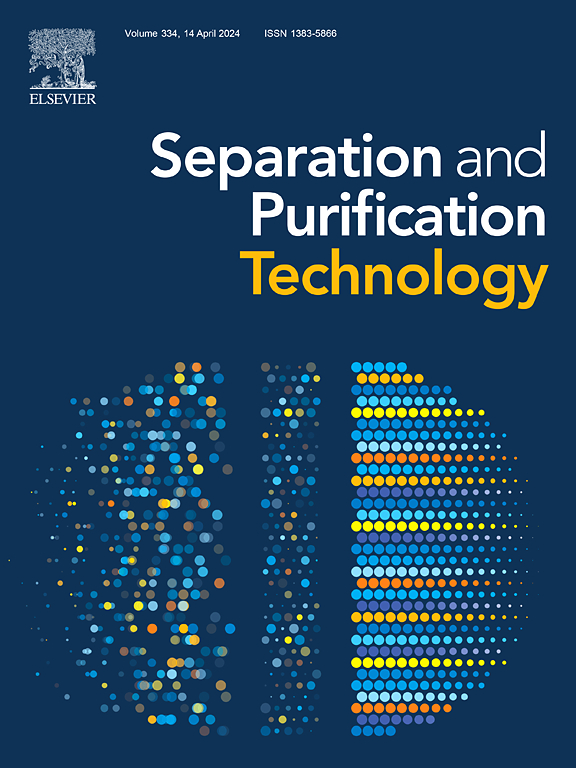Design and synthesis of defect-engineered POM@MOF catalysts for aerobic oxidative desulfurization
IF 9
1区 工程技术
Q1 ENGINEERING, CHEMICAL
引用次数: 0
Abstract
In this study, PW5V7@rht-MOF-1 (1) was prepared via one-pot hydrothermal synthesis and its crystal structure was confirmed by X-ray diffraction analysis. To enhance catalytic performance, a series of defect-engineered PW5V7@rht-MOF-1 (1-Dx) catalysts were further developed by using formic acid (FA) as a modulator. TG, PXRD, and BET analyses demonstrated that defects resulting from ligand deficiency in 1-Dx enhanced their specific surface area and porosity, while maintaining the overall structural integrity. XPS, EPR and Py-IR analyses revealed the presence of additional oxygen vacancies and Lewis acid sites in 1-D0.2. Experimental results show that, with the assistance of the surfactant, the optimized catalyst (1-D0.2) achieves 99.8% sulfur removal within 3 h at 100 °C, significantly improving upon the defect-free catalyst (71.1%). Cycle tests indicate that 1-D0.2 maintains 93.4% desulfurization efficiency after seven consecutive uses, demonstrating its structural stability. In addition, the radical oxidation mechanism of the AODS reaction was further validated by radical scavenging experiments and EPR. This study presents a novel strategy for designing defect-engineered POM@MOF catalysts and demonstrates their application in deep fuel desulfurization, highlighting the crucial role of defect engineering in heterogeneous catalysis.


缺陷工程POM@MOF好氧氧化脱硫催化剂的设计与合成
本研究通过一锅水热合成法制备了PW5V7@rht-MOF-1(1),并通过x射线衍射分析证实了其晶体结构。为了提高催化性能,以甲酸(FA)为调制剂,进一步开发了一系列缺陷工程PW5V7@rht-MOF-1 (1-Dx)催化剂。TG, PXRD和BET分析表明,1-Dx配体缺乏导致的缺陷增强了它们的比表面积和孔隙度,同时保持了整体结构的完整性。XPS, EPR和Py-IR分析显示在1-D0.2中存在额外的氧空位和Lewis酸位点。实验结果表明,在表面活性剂的辅助下,优化后的催化剂(1-D0.2)在100 ℃下,在3 h内的脱硫率达到99.8% %,显著提高了无缺陷催化剂(71.1 %)的脱硫率。循环试验表明,1-D0.2连续使用7次,脱硫效率保持在93.4 %,表明其结构稳定。此外,通过自由基清除实验和EPR进一步验证了AODS反应的自由基氧化机理。本研究提出了一种设计缺陷工程POM@MOF催化剂的新策略,并展示了其在深层燃料脱硫中的应用,突出了缺陷工程在多相催化中的重要作用。
本文章由计算机程序翻译,如有差异,请以英文原文为准。
求助全文
约1分钟内获得全文
求助全文
来源期刊

Separation and Purification Technology
工程技术-工程:化工
CiteScore
14.00
自引率
12.80%
发文量
2347
审稿时长
43 days
期刊介绍:
Separation and Purification Technology is a premier journal committed to sharing innovative methods for separation and purification in chemical and environmental engineering, encompassing both homogeneous solutions and heterogeneous mixtures. Our scope includes the separation and/or purification of liquids, vapors, and gases, as well as carbon capture and separation techniques. However, it's important to note that methods solely intended for analytical purposes are not within the scope of the journal. Additionally, disciplines such as soil science, polymer science, and metallurgy fall outside the purview of Separation and Purification Technology. Join us in advancing the field of separation and purification methods for sustainable solutions in chemical and environmental engineering.
 求助内容:
求助内容: 应助结果提醒方式:
应助结果提醒方式:


